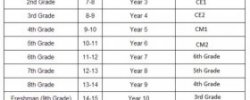International students who come to the United States may wonder about their American classmates' prior education. Due to its local variations, the American education system appears confusing. In addition, the structure and procedures at American universities differ somewhat from other systems, such as the British model. This is a brief overview of the American school and university systems.
To begin, because the country has a federal system of government that has historically valued local governance, no country-level education system or curriculum exists in the United States. The federal government does not operate public schools. Each of the fifty states has its own Department of Education that sets guidelines for the schools of that state. Public schools also receive funding from the individual state, and also from local property taxes. Public colleges and universities receive funding from the state in which they are located. Each state's legislative body decides how many tax dollars will be given to public colleges and universities. Students in grades 1-12 do not pay tuition. College and university students do pay tuition, but many earn scholarships or receive loans.
Much of the control of American public schools lies in the hands of each local school district. Each school district is governed by a school board; a small committee of people elected by the local community or appointed by the local government. The school board sets general policies for the school district and insures that state guidelines are met.
Generally, school districts are divided into elementary schools, middle schools, and high schools. Elementary schools are composed of students in kindergarten and grades 1-5. Most children attend kindergarten when they are five-years-old. Children begin 1st grade at age six. Middle school is composed of students in grades 6-8 and high school contains grades 9-12.
High school students are required to take a wide variety of courses in English, mathematics, science, and social science. They may also be required to take foreign language or physical education, and they may elect to take music, art, or theatre courses. Many high schools also offer vocational training courses. A course can be one semester or two semesters in length. The academic year generally begins in mid August and ends in early June.
In the United States, education is compulsory for all students until ages sixteen to eighteen depending on the individual state. According to the 2010 U.S. Census, 87.1% of people over the age of 25 were high school graduates. Most high school students graduate at the age of seventeen or eighteen-years-old. A student graduates after he or she has successfully passed all of the required courses. Grades are given to students for each course at the end of each semester. The grading scale is A (excellent), B (above average), C (average), D (below average), and F (failing). A student who fails a required course must repeat the course.
The Bureau of Labor Statistics reports that 66.2% of 2012 high school graduates were enrolled in college in October 2012. Students have the option of attending a two-year community college (also known as a junior college) before applying to a four-year university. Admission to community college is easier, tuition is lower, and class sizes are often smaller than in a university. Community college students can earn an Associate's degree and transfer up to two years of course credits to a university.
rtve researchgate astro.wisc.edu engawa.kakaku.com search.auone.jp telstra.com.au sitereport.netcraft.com wikimapia.org nutritiondata.self.com kaskus.co.id digitalcollections.clemson.edu superherohype.com tools.folha.com.br talgov.com minecraft.curseforge.com curseforge.com foro.infojardin.com camfrog.com popcouncil.org drinksmixer.com bonanza.com hkex.com.hk inginformatica.uniroma2.it sie.gov.hk ime.nu domaindirectory.com opendns.com









